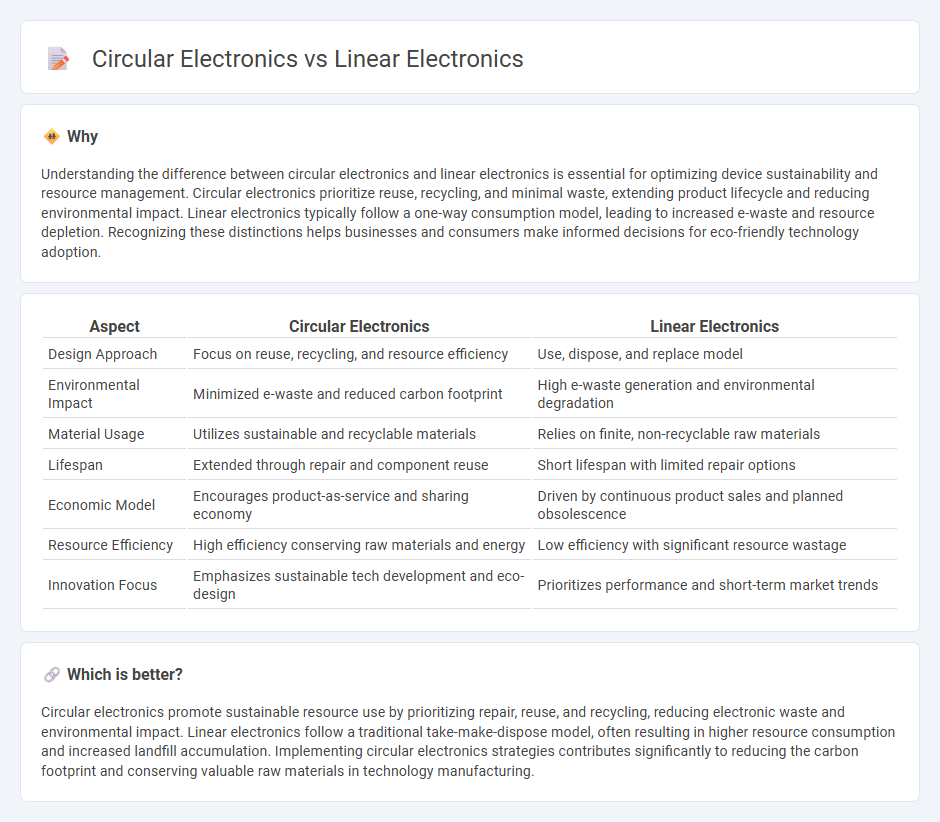
Circular electronics focus on sustainable design by promoting reuse, repair, and recycling of electronic components to reduce waste and environmental impact. Linear electronics follow a traditional cradle-to-grave model where products are manufactured, used, and discarded, contributing to e-waste accumulation. Explore the benefits and challenges of circular versus linear electronics to understand their impact on the future of technology.
Why it is important
Understanding the difference between circular electronics and linear electronics is essential for optimizing device sustainability and resource management. Circular electronics prioritize reuse, recycling, and minimal waste, extending product lifecycle and reducing environmental impact. Linear electronics typically follow a one-way consumption model, leading to increased e-waste and resource depletion. Recognizing these distinctions helps businesses and consumers make informed decisions for eco-friendly technology adoption.
Comparison Table
| Aspect | Circular Electronics | Linear Electronics |
|---|---|---|
| Design Approach | Focus on reuse, recycling, and resource efficiency | Use, dispose, and replace model |
| Environmental Impact | Minimized e-waste and reduced carbon footprint | High e-waste generation and environmental degradation |
| Material Usage | Utilizes sustainable and recyclable materials | Relies on finite, non-recyclable raw materials |
| Lifespan | Extended through repair and component reuse | Short lifespan with limited repair options |
| Economic Model | Encourages product-as-service and sharing economy | Driven by continuous product sales and planned obsolescence |
| Resource Efficiency | High efficiency conserving raw materials and energy | Low efficiency with significant resource wastage |
| Innovation Focus | Emphasizes sustainable tech development and eco-design | Prioritizes performance and short-term market trends |
Which is better?
Circular electronics promote sustainable resource use by prioritizing repair, reuse, and recycling, reducing electronic waste and environmental impact. Linear electronics follow a traditional take-make-dispose model, often resulting in higher resource consumption and increased landfill accumulation. Implementing circular electronics strategies contributes significantly to reducing the carbon footprint and conserving valuable raw materials in technology manufacturing.
Connection
Circular electronics incorporate sustainable design principles by enabling the reuse and recycling of materials, contrasting with traditional linear electronics that follow a "take-make-dispose" model. The connection lies in transitioning from linear supply chains toward circular systems that minimize e-waste and promote resource efficiency. Advances in modular components and biodegradable materials play a critical role in bridging these two electronics lifecycles.
Key Terms
Signal Processing
Linear electronics, characterized by components such as resistors, capacitors, and operational amplifiers, perform signal processing through continuous and proportional changes in voltage or current, ensuring high fidelity and minimal distortion in analog signals. Circular electronics, often associated with ring oscillators and feedback loops, utilize cyclic signal paths to enhance stability, frequency response, and noise reduction in complex signal processing applications. Explore the advancements and applications of these electronic paradigms in signal processing to deepen your understanding.
Feedback Loop
Linear electronics rely on straightforward signal pathways, often resulting in limited feedback loop complexity and slower adaptation to changes. Circular electronics integrate continuous feedback loops that enhance system stability, enable real-time adjustments, and improve performance efficiency. Explore how advanced feedback loop designs in circular electronics revolutionize modern electronic systems.
Circuit Topology
Linear electronics rely on sequential circuit topologies where signals flow in a straight path from input to output, optimizing simplicity and predictability in design. Circular electronics employ looped or feedback circuit topologies to enhance signal processing by enabling continuous monitoring and adjustment within the system. Explore more on how these distinct circuit topologies impact electronic device efficiency and performance.
Source and External Links
Linear circuit - Wikipedia - A linear circuit is an electronic circuit that obeys the superposition principle, meaning its output is a linear function of its input, allowing signal amplification and processing without distortion.
Linear Devices in Electronics and How They Affect Your Signals - Linear devices have outputs directly proportional to their inputs, though most real-world devices exhibit nonlinear behavior at some operating conditions, with transistors and integrated circuits having linear ranges at low signal levels.
The Basics of Linear vs. Nonlinear Circuits - PCB Design & Analysis - Linear circuits, often built with resistors, capacitors, and inductors, maintain a linear relationship between input and output, unlike nonlinear circuits which are essential for digital logic and modern electronics.
 dowidth.com
dowidth.com